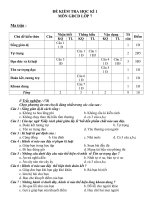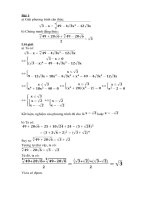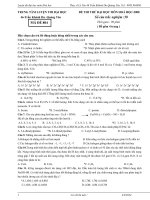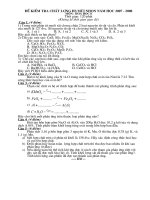Đáp án oracle OCA 1z0 061 đề 2
Bạn đang xem bản rút gọn của tài liệu. Xem và tải ngay bản đầy đủ của tài liệu tại đây (817.97 KB, 17 trang )
Câu 1:
In which three situations does a transaction complete?
Trả lời:
[A]. When a DELETE statement is executed
[B]. When a ROLLBACK command is executed
[C]. When a PL/SQL anonymous block is executed
[D]. When a data definition language (DDL) statement is executed
[E]. When a TRUNCATE statement is executed after the pending transaction
Hướng dẫn:
B
D
E
Câu 2:
Which two statements are true regarding constraints?
Trả lời:
[A]. A foreign key cannot contain null values.
[B]. A column with the unique constraint can contain null values.
[C]. A constraint is enforced only for the insert operation on a table.
[D]. A constraint can be disabled even if the constraint column contains data.
[E]. All constraints can be defined at the column level as well as the table level.
Hướng dẫn:
B
D
B: Any number of rows can include nulls for columns without NOT NULL constraints
because nulls are not considered equal to anything.
D: Constraints can be added, dropped, enabled, disabled, or validated. DISABLE allows
incoming data, regardless of whether it conforms to the constraint
Incorrect:
Not A: The relational model permits the value of foreign keys either to match the
referenced primary or unique key value, or be null.
Reference: />
Câu 3:
You issued the following command:
SQL> DROP TABLE employees;
Which three statements are true?
Trả lời:
[A]. All uncommitted transactions are committed.
[B]. All indexes and constraints defined on the table being dropped are also dropped.
[C]. Sequences used in the employees table become invalid.
[D]. The space used by the employees table is reclaimed immediately.
[E]. The employees table can be recovered using the rollback command.
[F]. The employees table is moved to the recycle bin.
Hướng dẫn:
A
B
F
A: If a user issues a DDL (CREATE, ALTER, or DROP) or DCL (GRANT or REVOKE)
command, the transaction in progress (if any) will be committed.
B: Dropping a table invalidates dependent objects, such as indexes and constraints.
F: The DROP TABLE statement moves a table or object table to the recycle bin.
Incorrect:
Not B: In general sequences used in the table would not by affected when the table is
dropped.
Not D: Unless you specify the PURGE clause, the DROP TABLE statement does not
result in space being released back to the tablespace for use by other objects, and the
space continues to count toward the user's space quota.
Not E: Dropping a table invalidates dependent objects and removes object privileges on
the table. If you want to re-create the table, then you must regrant object privileges on
the table, re-create the indexes, integrity constraints, and triggers for the table, and
respecify its storage parameters.
Reference:
/>Câu 4:
Which create table statement is valid?
Trả lời:
[A]. Option A
[B]. Option B
[C]. Option C
[D]. Option D
Hướng dẫn:
D
PRIMARY KEY Constraint
A PRIMARY KEY constraint creates a primary key for the table. Only one primary key
can be created for each table. The PRIMARY KEY constraint is a column or a set of
columns that uniquely identifies each row in a table. This constraint enforces the
uniqueness of the column or column combination and ensures that no column that is
part of the primary key can contain a null value.
Note: Because uniqueness is part of the primary key constraint definition, the Oracle
server enforces the uniqueness by implicitly creating a unique index on the primary key
column or columns.
Incorrect:
Not A: Two primary keys are not allowed.
Not B: You cannot specific a column to be both UNIQUE and NOT NULL.
Not C: The default value cannot be NOT NULL.
Câu 5:
Examine the data in the CUST_NAME column of the customers table.
You need to display customers' second names where the second name starts with "Mc"
or "MC."
Which query gives the required output?
Trả lời:
[A]. Option A
[B]. Option B
[C]. Option C
[D]. Option D
Hướng dẫn:
B
Câu 6:
Examine the structure of the employees table.
You want to display the maximum and minimum salaries of employees hired 1 year ago.
Which two statements would get the correct output?
Trả lời:
[A]. Option A
[B]. Option B
[C]. Option C
[D]. Option D
Hướng dẫn:
A
C
Incorrect:
Not B, not D: You cannot use a GROUP BY clause in a WHERE statement.
Câu 7:
Examine the structure and data of the CUST_TRANS table:
Dates are stored in the default date format dd-mon-rr in the CUST_TRANS table. Which
three SQL statements would execute successfully?
Trả lời:
[A]. SELECT transdate + '10' FROM cust_trans;
[B]. SELECT * FROM cust_trans WHERE transdate = '01-01-07';
[C]. SELECT transamt FROM cust_trans WHERE custno > '11';
[D]. SELECT * FROM cust_trans WHERE transdate='01-JANUARY-07';
[E]. SELECT custno + 'A' FROM cust_trans WHERE transamt > 2000;
Hướng dẫn:
A
C
D
Câu 8:
Examine the structure of the products table:
You want to display the names of the products that have the highest total value for
UNIT_PRICE * QTY_IN_HAND.
Which SQL statement gives the required output?
Trả lời:
[A]. Option A
[B]. Option B
[C]. Option C
[D]. Option D
Hướng dẫn:
A
Câu 9:
View the Exhibit and examine the structure of the promotions table.
Evaluate the following SQL statement:
Which statement is true regarding the outcome of the above query?
Trả lời:
[A]. It shows COST_REMARK for all the promos in the table.
[B]. It produces an error because the SUBQUERY gives an error.
[C]. It shows COST_REMARK for all the promos in the promo category 'TV'
[D]. It produces an error because SUBQUERIES cannot be used with the case
expression.
Hướng dẫn:
A
Câu 13:
The customers table has the following structure:
You need to write a query that does the following tasks:
1. Display the first name and tax amount of the customers. Tax is 5% of their credit limit.
2. Only those customers whose income level has a value should be considered.
3. Customers whose tax amount is null should not be considered.
Which statement accomplishes all the required tasks?
Trả lời:
[A]. Option A
[B]. Option B
[C]. Option C
[D]. Option D
Hướng dẫn:
B
Câu 14:
Examine the structure of the orders table:
You want to find the total value of all the orders for each year and issue the following
command:
Which statement is true regarding the outcome?
Trả lời:
[A]. It executes successfully and gives the correct output.
[B]. It gives an error because the TO_CHAR function is not valid.
[C]. It executes successfully but does not give the correct output.
[D]. It gives an error because the data type conversion in the SELECT list does not
match the data type conversion in the GROUP BY clause.
Hướng dẫn:
D
The correct code would be:
SELECT TO_CHAR(order_date, 'rr'), SUM(order_total)
FROM orders
GROUP BY TO_CHAR(order_date, 'rr');
Câu 16:
View the Exhibit and examine the structures of the employees and departments tables.
You want to update the employees table as follows:
-Update only those employees who work in Boston or Seattle (locations 2900 and 2700).
-Set department_id for these employees to the department_id corresponding to London
(location_id 2100).
-Set the employees' salary in iocation_id 2100 to 1.1 times the average salary of their
department.
-Set the employees' commission in iocation_id 2100 to 1.5 times the average
commission of their department.
You issue the following command:
What is the outcome?
Trả lời:
[A]. It executes successfully and gives the correct result.
[B]. It executes successfully but does not give the correct result.
[C]. It generates an error because a subquery cannot have a join condition in an update
statement.
[D]. It generates an error because multiple columns (SALARY, COMMISSION) cannot
be specified together in an update statement.
Hướng dẫn:
B
Not that employees is used both in the first line (UPDATE employees) and later (FROM
employees, departments). This would not cause the correct output. Instead aliases
should be use.
The following would be the correct query:
UPDATE employees a
SET department_id =
(SELECT department_id
FROM departments
WHERE location_id = '2100'),
(salary, commission_pct) =
(SELECT 1.1*AVG(salary), 1.5*AVG(commission_pct)
FROM employees b
WHERE a.department_id = b.department_id)
WHERE department_id IN
(SELECT department_id
FROM departments
WHERE location_id = 2900
OR location_id = 2700);
Reference:
/>Câu 17:
Which statement is true regarding the UNION operator?
Trả lời:
[A]. By default, the output is not sorted.
[B]. Null values are not ignored during duplicate checking.
[C]. Names of all columns must be identical across all select statements.
[D]. The number of columns selected in all select statements need not be the same.
Hướng dẫn:
B
For the UNION operator the nulls values are not ignored during duplicate checking.
Incorrect:
Not A: The UNION operator implicitly sorts the output.
Not D: Each SQL SELECT statement within the UNION query must have the same
number of fields in the result sets with similar data types.
Câu 18:
View the Exhibits and examine the structures of the products, sales, and customers
tables.
You need to generate a report that gives details of the customer's last name, name of
the product, and the quantity sold for a customers in 'Tokyo'.
Which two queries give the required result?
Trả lời:
[A]. Option A
[B]. Option B
[C]. Option C
[D]. Option D
Hướng dẫn:
A
C
Câu 20:
You want to display 5 percent of the rows from the sales table for products with the
lowest AMOUNT_SOLD and also want to include the rows that have the same
AMOUNT_SOLD even if this causes the output to exceed 5 percent of the rows.
Which query will provide the required result?
Trả lời:
[A]. Option A
[B]. Option B
[C]. Option C
[D]. Option D
Hướng dẫn:
D
The FETCH statement must include WITH TIES.
Incorrect:
Not B: You cannot use ROWS WITH in a FETCH statement.









